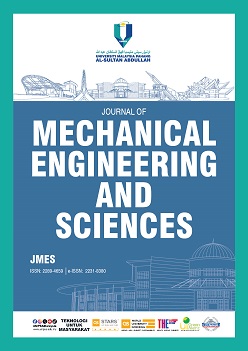Box-Behnken design application to optimize swirl effervescent droplet mean diameter
DOI:
https://doi.org/10.15282/jmes.18.4.2024.2.0808Keywords:
Swirl effervescent atomization, Droplet mean diameter, Design of experiment, Shadowgraph, Image processingAbstract
Swirl effervescent atomization combines the principles of swirling and bubbling liquids to create a wider spray pattern while using less liquid than traditional methods. The diameter of the resulting droplets, a key feature in atomization performance, is influenced by various dimensionless numbers such as the gas-to-liquid ratio and the Reynolds number. A design of experiments approach was used instead of the traditional one-factor-at-a-time testing to study these factors efficiently. A novel swirl effervescent atomizer was fabricated. Shadowgraph was used to capture droplet images and image processing was used to analyze the droplet diameter. The increase of the liquid Reynolds number from 847 to 2540 causes the Sauter mean diameter to decrease. The increase of gas Reynolds number from 0 to 1514 caused a decrease in the Sauter mean diameter. Increasing the swirl chamber length to discharge orifice diameter ratio causes an increase in Sauter mean diameter. A mathematical model was proposed and satisfies the goodness-of-fit in regression and ANOVA. It was discovered that significant impacts on the droplet mean diameter were exerted by changes in the gas and liquid Reynold numbers but the steeper reduction of the Sauter mean diameter was observed with the change of gas Reynolds number. Meanwhile, minimal effect was found to be exerted by the swirl chamber length to discharge orifice diameter ratio. The results show that the developed mathematical model can accurately predict the correlation of the Sauter mean diameter with the aforementioned factor.
References
[1] A. Kushari, S. Pandey, “A controllable twin-fluid internally mixed swirl atomizer,” Recent Patents on Mechanical Engineering, vol. 1, no. 1, pp. 45–50, 2008.
[2] A. H. Lefebvre, V. G. McDonell, Atomization and Sprays, 2nd Eds. Boca Raton: CRC Press, 2017.
[3] G. Li, C. Li, “Experimental study on the spray steadiness of an internal-mixing twin-fluid atomizer,” Energy, vol. 226, p. 120394, 2021.
[4] Z. A. Ghaffar, A. H. A. Hamid, M. S. F. M. Rashid, “Spray characteristics of swirl effervescent injector in rocket application: A review,” Applied Mechanics and Materials, vol. 225, pp. 423-428, 2012.
[5] M. Mlkvik, P. Stähle, H. P. Schuchmann, V. Gaukel, J. Jedelsky, M. Jicha, “Twin-fluid atomization of viscous liquids: The effect of atomizer construction on breakup process, spray stability and droplet size,” International Journal of Multiphase Flow, vol. 77, pp. 19–31, 2015.
[6] S. Wachter, T. Jakobs, T. Kolb, “Experimental investigation on the influence of system pressure on resulting spray quality and jet breakup applying pressure adapted twin-fluid nozzles,” International Journal of Multiphase Flow, vol. 125, p. 103189, 2020.
[7] H. Liu. Science and Engineering of Droplets: Fundamentals and Applications. 1st Ed. New York: Noyes Publications, 2000.
[8] M. Lörcher, F. Schmidt, D. Mewes, “Effervescent atomization of liquids,” Atomization and Sprays, vol. 15, no. 2, pp. 145–168, 2005.
[9] R. A. Mugele, H. D. Evans, “Droplet size distribution in sprays,” Industrial and Engineering Chemistry, vol. 43, no. 6, pp. 1317–1324, 1951.
[10] J. Van Strien, S. Vahaji, P. Lappas, D. Morton, K. Inthavong, “Spatial and temporal characterization of droplet diameter and velocities of a nasal spray atomization,” Aerosol Science and Technology, vol. 58, no. 6, pp. 610–629, 2024.
[11] J. Barroso, A. Lozano, F. Barreras, E. Lincheta, “Analysis and prediction of the spray produced by an internal mixing chamber twin-fluid nozzle,” Fuel Processing Technology, vol. 128, pp. 1–9, 2014.
[12] S. K. Vankeswaram, R. Sakthikumar, S. Deivandren, J. D. C. Hu, “Evaluation of spray characteristics of aviation biofuels and Jet A-1 from a hybrid airblast atomizer,” Experimental Thermal and Fluid Science, vol. 142, p. 110820, 2023.
[13] R. H. Myers, D. C. Montgomery, C. M. Anderson-Cook. Response Surface Methodology: Process and Product Optimization Using Designed Experiments, 3rd Eds. New Jersey: John Wiley and Sons, 2009.
[14] H. Liu, K. Wang, W. Schlindwein, M. Li, “Using the Box-Behnken experimental design to optimise operating parameters in pulsed spray fluidised bed granulation,” International Journal of Pharmaceutics, vol. 448, no. 2, pp. 329–338, 2013.
[15] S. L. C. Ferreira, R. E. Bruns, H. S. Ferreira, G. D. Matos, J. M. David, G. C. Brandão, et al., “Box-Behnken design: An alternative for the optimization of analytical methods,” Analytica Chimica Acta, vol. 597, no. 2, pp. 179–186, 2007.
[16] P. G. Mathews. Design of Experiments with MINITAB. 1st Ed. Milwaukee: ASQ Quality Press, 2005.
[17] A. Dean, D. Voss, D. Draguljić, Design and Analysis of Experiments, 2nd Eds. Cham: Springer International Publishing AG, 2017.
[18] O. Porwal, “Box-Behnken design-based formulation optimization and characterization of spray dried rutin loaded nanosuspension: State of the art,” South African Journal of Botany, vol. 149, pp. 807–815, 2022.
[19] R. Yakut, “Response surface methodology-based multi-nozzle optimization for electrospray cooling,” Applied Thermal Engineering, vol. 236, p. 121914, 2024.
[20] J. Qiu, Q. Zhang, B. Jiang, M. Tang, L. Zhou, “Analysis of the effect of water film dust removal of a tunnel’s full-section fog screen dust capture system,” Chemical Engineering Research and Design, vol. 209, pp. 258–271, 2024.
[21] P. Saiteja, B. Ashok, “Study on interactive effects of CRDi engine operating parameters through RSM based multi-objective optimization technique for biofuel application,” Energy, vol. 255, p. 124499, 2022.
[22] Z. A. Ghaffar, S. Kasolang, A. H. A. Hamid, C. S. Ow, N. R. Nik Roselina, “Design, development and performance evaluation of new swirl effervescent injector,” Jurnal Teknologi, vol. 75, no. 1, pp. 19-25, 2015.
[23] Z. A. Ghaffar, S. Kasolang, A. H. A. Hamid, “Optimization of swirl effervescent spray dispersity via response surface methodology,” International Transaction Journal of Engineering, Management, & Applied Sciences & Technology, vol. 13, no. 13, p. 13A13H, 2022.
[24] J. D. Whitlow, A. H. Lefebvre, R. J. Rollbuhler, “Experimental studies on effervescent atomizers with wide spray angles,” in AGARD Conference Proceedings: Fuels and Combustion Technology for Advanced Aircrafi Engines, pp. 1-11, 1993.
[25] J. Jedelsky, M. Jicha, “Novel modifications of twin-fluid atomizers: performance, advantages and drawbacks,” in Proceedings of the 23rd Annual Conference on Liquid Atomization and Spray Systems ILASS-Europe, vol. 23, pp. 1-5, 2010.
[26] M. Ochowiak, “Discharge coefficient of effervescent atomizers with the swirl motion phenomenon,” Experimental Thermal and Fluid Science, vol. 79, pp. 44–51, 2016.
[27] L. Liu, N. Pei, R. Zhao, L. Tian, R. Duan, Y. Zhang, et al., “Effect of the two-phase hybrid mode of effervescent atomizer on the atomization characteristics,” Open Physics, vol. 17, no. 1, pp. 960–965, 2019.
[28] J. Xie, L. Liu, X. Huo, X. Liu, R. Duan, “Numerical and experimental study of wire mesh in the swirl effervescent atomization,” Physics of Fluids, vol. 35, no. 8, 2023.
[29] Z. A. Ghaffar, S. Kasolang, A H. A. Hamid, Z. Eshak, “Experimental analysis of tangential-vane swirl atomizer spray angle,” Journal of Advanced Research in Fluid Mechanics and Thermal Sciences, vol. 101, no. 2, pp. 1–7, 2023.
[30] B. Stewart. Adventures in Arduino. 1st Ed. West Sussex: John Wiley and Sons, 2015.
[31] M. J. Anderson, P. J. Whitcomb. DOE Simplified: Practical Tools for Effective Experimentation, 3rd Eds. Boca Raton: CRC Press, 2007.
[32] S. Kim, T. Khil, D. Kim, Y. Yoon, “Effect of geometric parameters on the liquid film thickness and air core formation in a swirl injector,” Measurement. Science and Technology, vol. 20, no. 1, p. 015403, 2009.
[33] K. O. Fong, X. Xue, R. Osuna-Orozco, A. Aliseda, “Gas–liquid coaxial atomization with swirl in high-pressure environments,” International Journal of Multiphase Flow, vol. 174, p. 104767, 2024.
[34] V. S. Jagadale, D. Deshmukh, D. Hanstorp, Y. N. Mishra, “Bubble dynamics and atomization of acoustically levitated diesel and biodiesel droplets using femtosecond laser pulses,” Scientific Reports, vol. 14, no. 1, p. 8285, 2024.
[35] A. Asgarian, Z. Yang, Z. Tang, M. Bussmann, K. Chattopadhyay, “An image feature consolidation technique (IFCT) to capture multi-range droplet size distributions in atomizing liquid sheets,” Experiments in Fluids, vol. 61, no. 14, pp. 1-22, 2020.
[36] U. M. R. Paturi, N. S. Reddy, S. Cheruku, S. K. R. Narala, K. K. Cho, M. M. Reddy, “Estimation of coating thickness in electrostatic spray deposition by machine learning and response surface methodology,” Surface and Coatings Technology, vol. 422, p. 127559, 2021.
[37] A. Saha, J. D. Lee, S. Basu, R. Kumar, “Breakup and coalescence characteristics of a hollow cone swirling spray,” Physics of Fluids, vol. 24, no. 12, pp. 1-21, 2012.
[38] M. Rashad, H. Yong, Z. Zekun, “Effect of geometric parameters on spray characteristics of pressure swirl atomizers,” International Journal of Hydrogen Energy, vol. 41, no. 35, pp. 15790–15799, 2016.
[39] M. Goodarzi, P. Shahbazikhah, M. R. Sohrabi, M. Fathabadi, S. H. Nouri, “Direct orthogonal signal correction-partial least squares for simultaneous spectrophotometric determination of sulfamethoxazole and trimethoprim in pharmaceutical formulation and synthetic samples,” Journal of the Chilean Chemical Society, vol. 54, no. 3, pp. 309–313, 2009.
[40] R. J. Klein, S. E. Proctor, M. A. Boudreault, K. M. Turczyn, “Healthy People 2010 criteria for data suppression,” Healthy People 2010 Statistical Notes, vol. 24, no. 1237, pp. 1–12, 2002.
Downloads
Published
Issue
Section
License
Copyright (c) 2024 The Author(s)

This work is licensed under a Creative Commons Attribution-NonCommercial 4.0 International License.






